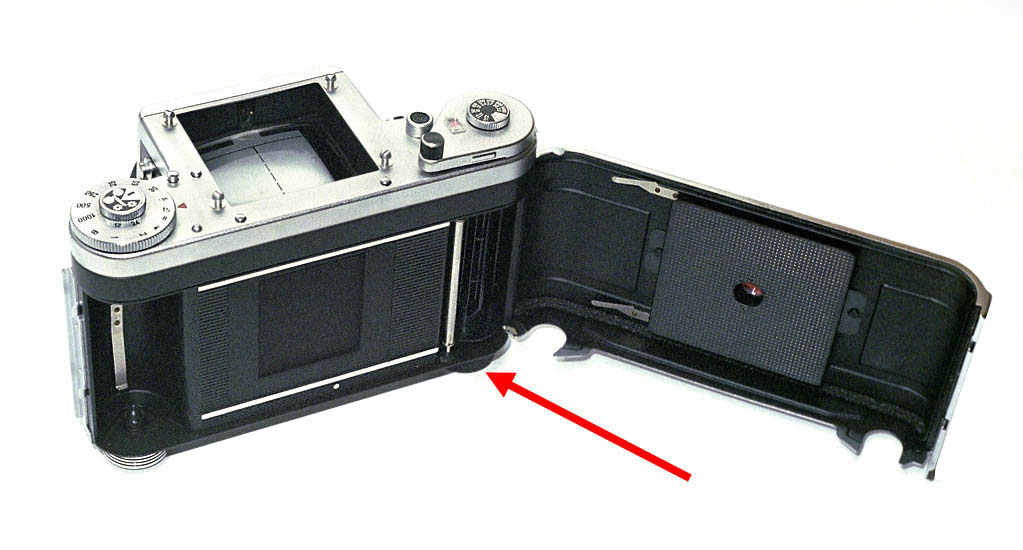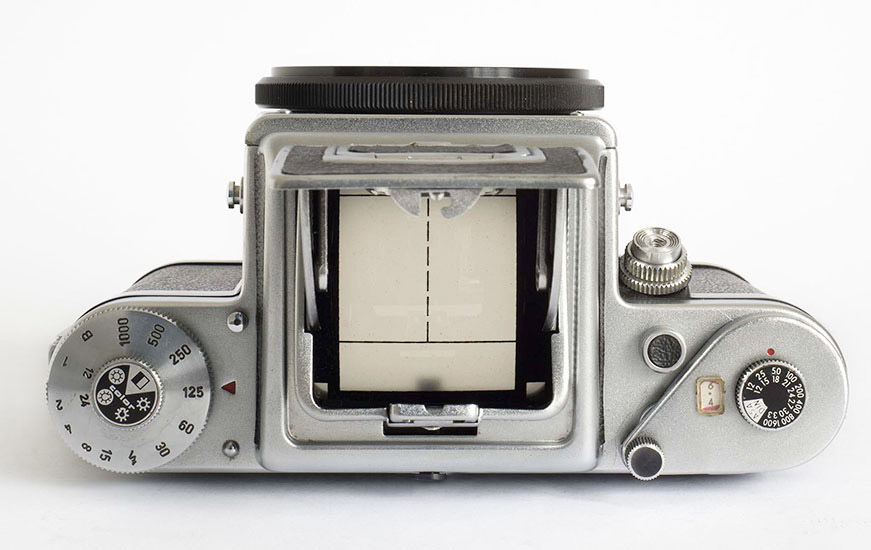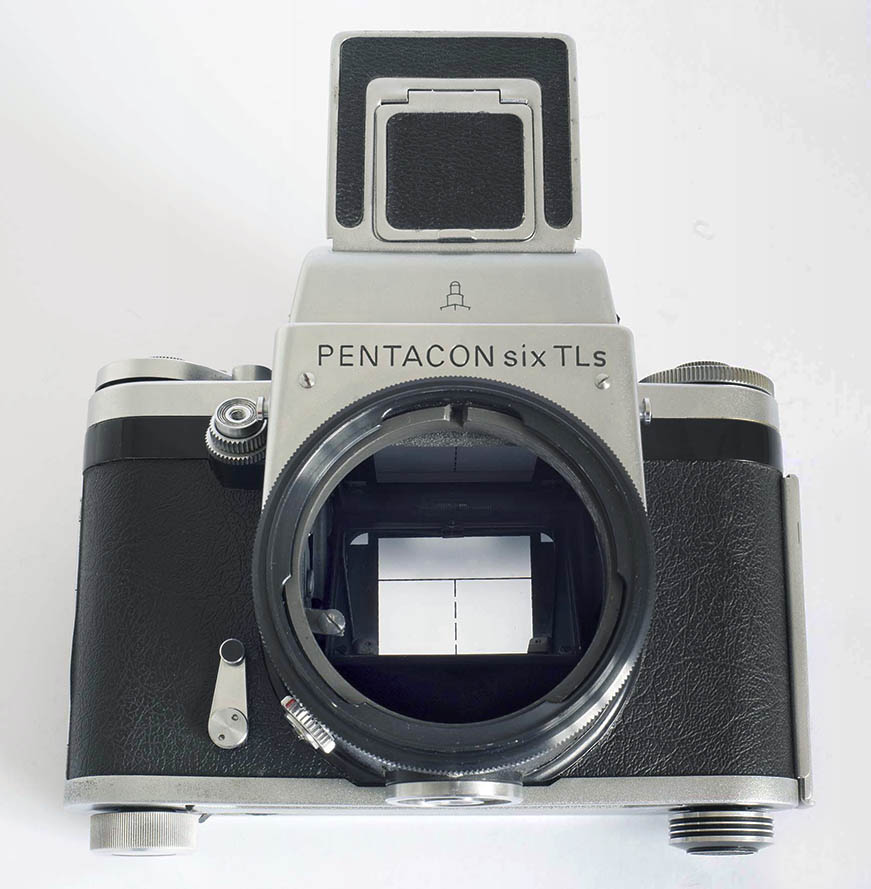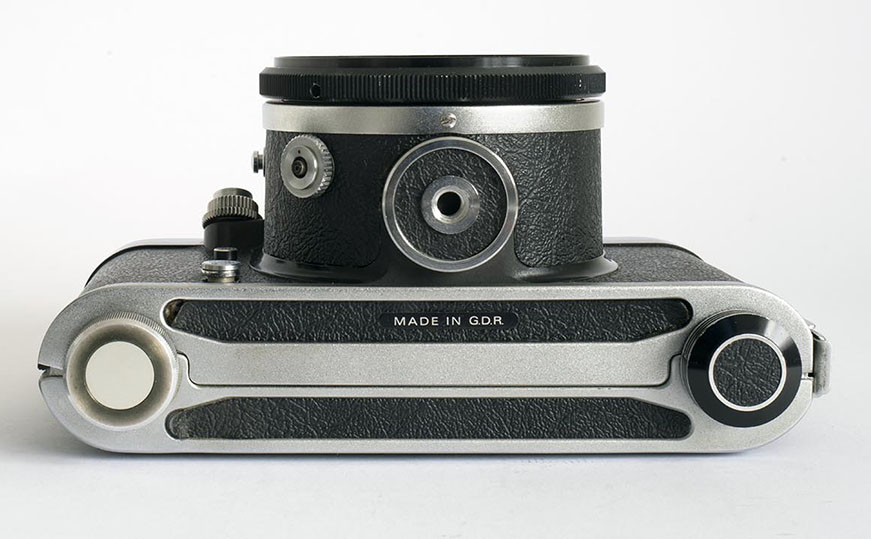by TRA
The History of the Pentacon Six
The Pentacon Six TLs &
Praktisix/Pentacon Six export models
Pentacon Six TLs
Dates: apparently
1983/84 on
This version of the Pentacon Six TL incorporated modifications of standard Pentacon Six TL cameras.
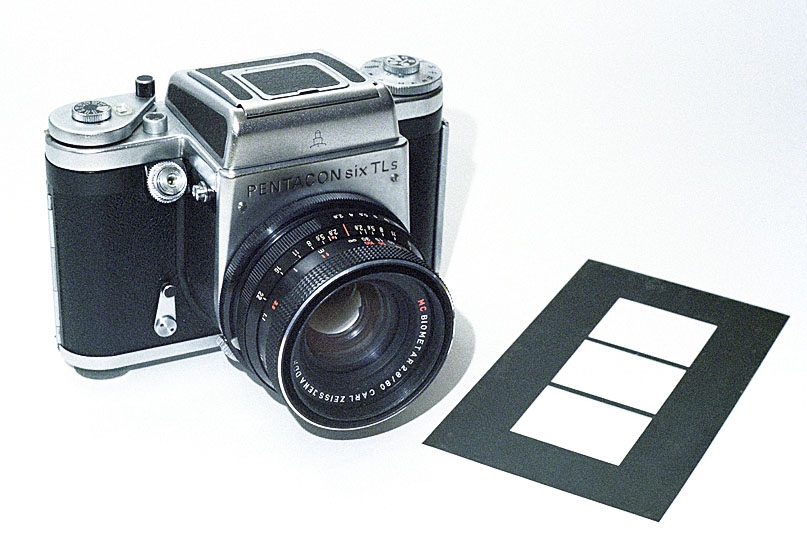
I assume that the mask (right)
supplied with the Pentacon Six TLs facilitated the
contact printing of the negatives onto paper.
Perhaps three photographs were taken of each person:
full-face, left profile and right profile.
This mask was presumably designed to be placed on the
developed negatives when making contact prints,
to mask out the spaces between the frames, the film
rebates (top and bottom edges) and the unexposed
portions of the original full 6×6 frame.
(This is not the mask that was
added to the film gate when the camera was modified.
For that, see the image below left.)
[C396_18.jpg]
The modification was produced for the Czechoslovak (as they were at that time) police as an ID photo camera. It was probably modified in Czechoslovakia and as such is not a variation produced by the Pentacon factory.
It produced sixteen (I
believe!) vertical images with nominal
dimensions of “4 × 6” cm. Measuring the
dimensions of the mask in the film gate in January
2019, I saw that the actual dimensions were
approximately 4 × 4.5 cm. More careful
measurement of the film gate in another Pentacon Six
TLs now indicates that the actual width of the gate is
approximately 38mm.
| I am grateful to
Krzysztof from Warsaw, who in June 2019 gave me
further information on the probable dimensions of
the film gate: “I checked Polish law on identification documents in the eighties: 35x45 mm ID photos (for ID cards and passports) were required in Poland, so it is very likely, that the same dimensions were required in Czechoslovakia too.” Thank you, Krzysztof, for this interesting information and for helping me to improve this page! The “extra” approximately 3mm of width probably allowed for minor inaccuracies when placing the film under the above frame for the production of contact prints, and to ensure that the unexposed rebates between the frames were fully masked. |
The camera’s standard “film-advance
lever” was decoupled from film advance and only served
to cock the shutter, lower the mirror and open the
lens aperture to maximum. The film was advanced
by a knob that replaced the right-hand film spool knob
(viewed from behind), and the correct spacing was
determined by using a red window in the back of the
camera. The lever wind does not block after the
12th (and 24th) frame, as on standard Pentacon Six
cameras, but after 18 frames. However, this
number includes the initial winding and firing before
the first frame, so perhaps the actual usable number
of frames is fifteen. The lever wind block is
released by a new, smaller, unblocking lever in the
same position as the original lever (for the purpose
of winding the film fully onto the take-up spool
before opening the back).
|
||||||||||||
| Krzysztof has
written again: “It might also be interesting that
a red window added to P6 TLs to determine film
spacing seems to be positioned centrally (am I
right?). If so, it would show numbers for
6x6 frames, which are 64 mm spaced. This
would make only 12 exposures and a nonsensical
waste of film; moreover the 3-frames mask
supplied with TLs would be useless because it has
much narrower frame spacing.” I replied, “You are right that the red window is indeed positioned centrally. This seems to me to have been an error at the design stage. If narrower spacing was to be used, the window should have been near the top of the pressure plate.” See the picture that shows the pressure plate, above, and the back of the camera, to the right here. Krzysztof continues, “I think that a following explanation is much probable: since TLs were produced for the Police, non-standard 120 film was used, perhaps also produced for the Police. It might have markings for non-standard frame spacing printed on the backing paper.” My reply: “The only solution for getting the new spacing would indeed have been to have different spacing printed on the backing paper, as you state. As both East Germany and some other eastern European countries produced black and white film, this could probably have been arranged – and something that was required by the state security services would have been done!” See the picture of 120 film backing paper, below. It has not been practical to include the whole of the length of the backing paper, but this picture shows how the spacing is normally indicated on 120 film backing paper. Of course, since at least the mid 1950s, most Medium Format film cameras have not needed to see these numbers, and have not had a red window, which could have “fogged” colour film! |
|
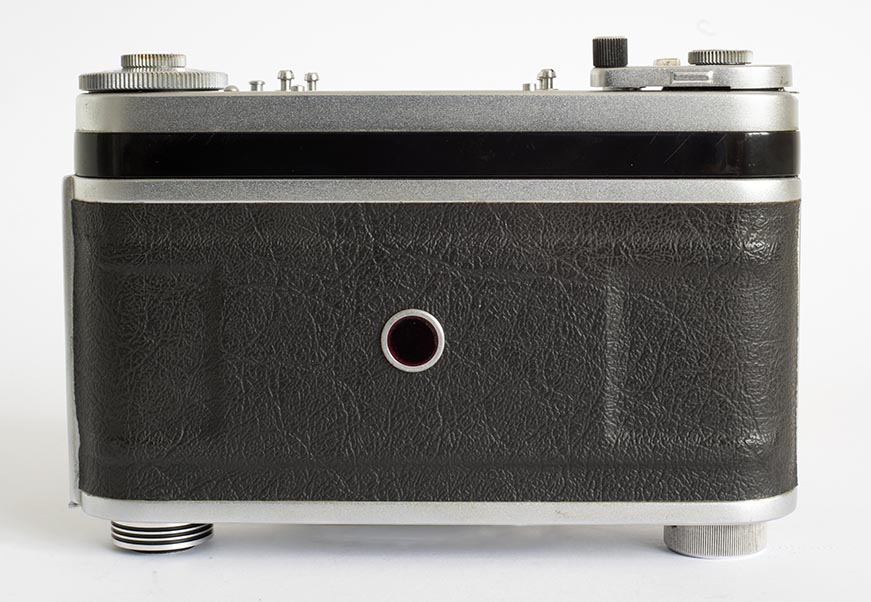 [P6TLs_07.jpg] |
 Part of the backing paper for a 120 film. The top two rows of numerals are for nominal 6×45 format. Those in the middle are for 6×6, and those at the bottom are for 6×9. The red window at the back of the Pentacon Six TLs could possibly have obtained suitable frame spacing by using the top two rows of numbers and dots, but perhaps the Czechoslovak police wanted more accurate spacing for their records. [backingppr.jpg] |
||
Export models
The various Praktisix models and the
Pentacon Six (+TL) were exported to many
countries around the world. Most of the
exported cameras were the standard model of the day,
but some of them had a special feature.
The special export versions of these cameras of which
I am currently aware were:
Dual flash sockets
cameras
A Praktisix/Pentacon Six collector reports:
| “I consider most
of the dual flash socket models to be export
models to the US. Almost all of these are
found in the US, including a very rare late
Praktisix (Model I). The Pentacon Sixes
with the “low TL” on the face plate are the most
prominent of these.” The other principal model of the Pentacon Six with the dual flash socket was the Hanimex Praktica 66, which is described in detail here. |
I am grateful to the same expert for
some of the further information on this page.
Pentacon Six TL
Italia
Date(s): ? – 1987
– ?
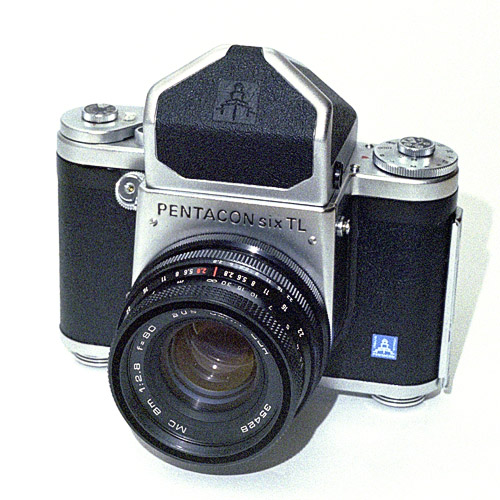 A very smart Pentacon Six TL Italia. I am surprised that this one was supplied with a plain prism – but then, professionals at the time often preferred to work with a hand-held meter. The lens left the production line on 15th May 1987. I note that it has an “export ring”, labelled “aus JENA” instead of “Carl Zeiss Jena” and “Bm” instead of “Biometar”. However, the East German régime was increasingly confident, politically, boasting that the “country” was “internationally recognised”. Accordingly, the lens is labelled “DDR”. [C396_21.jpg] |
Features
This was a version of the Pentacon Six
TL that was marketed in Italy. It appears to be
an unmodified Pentacon Six TL that had presumably
undergone an additional quality control by the
distributors, who applied to the front of the camera
(lower right, with the camera facing you) a smart blue
Pentacon logo with the words “ITALIA PENTACON
ITALIA”. The camera illustrated, which was
presumably manufactured in 1987, also has the shiny
shutter release button without the concentric circles
that had been seen on this button since the Praktisix
was first introduced in 1956/57.
This version of the camera seems to be
extremely rare, and I have only ever seen the one
illustrated here and one other example. According
to other reports, the “ITALIA PENTACON ITALIA” logo was
only applied to Praktica, that is 35mm,
cameras. However, this was clearly not the
case. At the same time, a guarantee sticker was
put in the left-hand spool chamber. This sticker
enables one to see the date of sale of the camera.
As the above camera does not belong to me, I can’t
easily check if the guarantee sticker is in it.
Versions with Italian logos
Over time, all three sticker variations
had been used on Pentacon Six TL cameras:
- Cattaneo (old)
- Cattaneo (new)
- Pentacon Italia.
Swiss Versions
- Praktisix IIa with decal SP F Switzerland
- Pentacon Six with decal SP F
Switzerland.
Both Cattaneos and the SP Fs are extremely rare (one of each known). The Italias are scarce. The "low TL" and the Hanimex are almost common. None of the export cameras are modified from the specifications of the original cameras.
For more information
on Praktisix and Pentacon cameras in Italy, see here.
To go on to the next section, click
below.
25 Similar cameras
from other manufacturers, based on the Pentacon Six
To go to the beginning of the history section, click here.
To go to introduction to the cameras, click here.
To choose other options, click below.
Home
© TRA First published: August 2010, Minor
clarification added: August 2023
